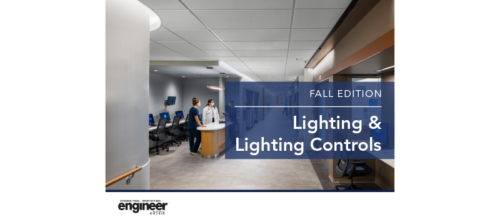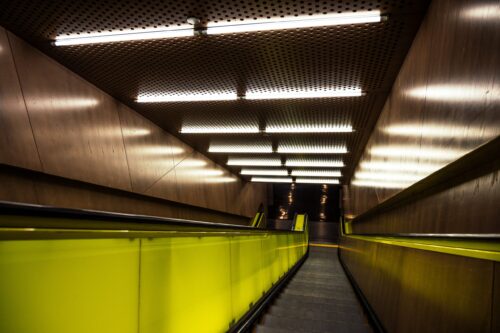Designing lighting control systems to meet the needs of all users
When designing lighting control systems, technology, energy efficiency and the user must be considered
Lighting insights
- Smart lighting systems use controls to help manage specific fixtures in a building or on a campus.
- By understanding the goals of the building owner and needs of the occupant, lighting control systems can meet both needs.
There has been a significant evolution of lighting controls over the past 20 years, from banks of standard light switches, to centralized relay control systems, to digital lighting controls connected to the network via Wi-Fi or low-voltage wiring. Smart lighting controls allow building managers to control the light level of a specific light fixture from across the nation via the internet.
These web-enabled lighting control systems can be programmed to provide cellphone alerts when the status of a room goes from vacant to occupied, triggering the lighting in the space to turn on. Internet-enabled technologies have become a powerful tool in reducing building energy use and improving facility efficiency.
Lighting control systems have gone from complex installations that perform a basic sequence of operations to a very simple installation that can perform complex operations. Detailed wiring diagrams to convey design intent have been replaced by written descriptions of how the space should function as functionality is dictated by system programming.
Given the increase in interest for buildings to achieve zero net electrical use, this progress has made it possible to further reduce a building’s energy use intensity via smart lighting systems. As engineers who interact with this technology daily, it’s easy to overlook the most important aspects of design: the building owner and the end user.
Understanding the goals of the lighting system
When designing a lighting control system, initial meetings with the owner’s staff are necessary to determine the staff’s level of technical savvy and establish the functional goals. Not every facility requires the level of control that allows a building manager to monitor the lighting status in a specific space through a graphical user interface. Often, the individual tasked with maintaining the lighting control system is someone who oversees all building functions and has little desire to learn a complex lighting control system, resulting in the need for a system that works and has low maintenance.

Figure 1: Consider how the space will be used when designing a system. Will multiple users occupy the space at once? Are individual light systems needed at each desk? Courtesy: Dewberry
As a design engineer, there is a level of education that also needs to take place when discussing the required functions of the lighting control system. Most states and municipalities have adopted an energy conservation code. These codes are specific to what lighting controls are required and how they are to function as a baseline for energy use reduction and must be followed regardless of the owner’s desired functionality.
The engineer should inform the owner of what is required and how that will be accomplished. If the engineer has adequately educated the building owner, then the owner should not be surprised by lights shutting off automatically in response to natural daylight levels. When designers include systems and features that were not requested by or discussed with the owner, frequently work-arounds are established that remove energy-saving features from the system.
For example, occupants may tape over photo sensors to eliminate the automatic functionality. The additional cost of the unwanted features would be better used in other aspects of the project. Designers should try to make the control system an asset to reduce their facility electrical usage rather than an unused icon in the building automation system (BAS). If the owner doesn’t know how to use it, it will not be used.
Gathering the full project scope
It’s important to consider that the owner may have additional desires unbeknownst to the design engineer. Perhaps they have multiple facilities under their supervision, for example college campuses, municipalities, corporate campuses or public school districts. If a lighting control system has been standardized, the owner should be alerting the design team that they must specify around that system.
The design engineer should inquire how the current system functions and try to emulate it in the new project while still complying with the current energy conservation code. If there is not an existing standardized system in place, the engineer may consider promoting the current project as an opportunity to create a standard.
Benefits to discuss with the owner include:
-
Familiarity of systems between all facilities for maintenance staff. The staff will not need to know multiple system specifics.
-
Reduced attic stock of lighting control devices. Replacement devices will work universally across all facilities that have been standardized.
-
Opportunity to network all facilities together for monitoring and control from a single location as future upgrades are made. This can also allow for remote access via the internet.
-
A single manufacturer or sales representative for technical assistance when issues arise. This single point of contact will be familiar with a system and may be able to troubleshoot the entire system remotely.

Figure 2: Typical wiring diagram. Courtesy: Dewberry
When assisting the owner in selecting a lighting control system, the engineer should present multiple alternatives.
Discuss the pros and cons between each, including:
-
The cost for replacement parts and long-term availability of parts.
-
Where the professional technical service is located and how quickly it can respond when the system needs repair or reprogramming.
-
The ease of which the owner can make changes to scheduling and device functionality on their own.
-
The amount of information that the system can provide, such as occupancy status, power use profiles and inputs to the BAS.
-
The potential for futureproofing the system as improvements are made. The manufacturer should indicate if and how they will be backward compatible with new system releases.
-
What is the cost for the added control features and can the project budget accommodate this cost?
Design engineers should understand that the owner is the one who will live and interact with the system for the lifetime of the building or campus. Understanding the owner’s level of technical aptitude and discussing how the system will work will not only benefit the design, but also the owner’s comfort with the system provided.

Figure 3: Generic layout with sequence of operations. Courtesy: Dewberry
Consider the end user
Similarly, the design engineer should consider the end user when designing and specifying the lighting control system. Who are the people using this facility and how will they be using it?
Consider a project that is an upgrade for a local church, which includes a multipurpose room. The owner informs the design team that the space will be used throughout the week by various groups, which may include senior citizens. This group of individuals may be more accustomed to lighting controls that consist of snap switches and rotary dimmers. In this instance, it would be prudent to provide an entry control station that more resembles a standard wall switch with clear on/off labeling versus a digital touch screen, which may be more commonly installed nowadays.
Understanding space use of lighting
How the lighting controls should function is also dependent on the application. In the 2012 International Energy Conservation Code, automatic daylight harvesting control became a requirement. To satisfy this code, the automatic controls may continuously dim or step-dim the lighting fixtures within the daylighting zone. The use of the space should have been considered when selecting the control method. In 2012, continuous dimming controls were more expensive than step-level dimming.
As the designer, it was good design to limit continuous dimming to areas where automatic reductions in light level would be distracting, such as classrooms, meeting rooms and office spaces. Corridors, library stack areas and lobbies could be step dimmed as occupants generally pass through these areas and are not focusing on a task for long periods of time.
Open offices pose a different challenge. In these spaces, individuals are often working under similar conditions. However, everyone has his own light level and temperature preferences. These spaces often span an area of up to 5,000 square feet and are controlled universally throughout the space.
One method to provide individual light level control is to provide task lighting at each space. Alternatively, individual fixture lighting controls allow for each inhabitant of the space to control the fixture directly above their workspace.

Figure 4: It’s important to understand how a facility manager may operate a system. If that individual is overseeing facilities for an entire school system, they may not have the capacity to manage a complex lighting system. Courtesy: Dewberry
Benefits to this control solution include:
-
Eliminating the need for task lighting in addition to general ambient lighting.
-
Providing flexibility for future furniture layouts.
-
Providing the ability to add enclosed spaces in the future with little to no rewiring of the existing lighting, rather, reprogramming of the system.
-
Minimizing the lighting required to be operating during building “closed” hours when employees are working after hours. Lighting near the worker can remain on, while the rest of the open office space can be shut off or reduced to minimal light output levels for energy savings.
As an evolving technology, smart lighting control systems regularly become increasingly flexible with fewer installation effort and more features. BAS integration will likely become a main component in energy use reduction and decarbonization of the built environment. It will be incumbent on the designers of these systems to make sure they are in line with the desires and capabilities of building owners and managers.
Additionally, the controls need to align with the needs of the end users. If the designer provides an overly complex system, it likely won’t be used as intended and the desired energy savings will not be achieved.
Do you have experience and expertise with the topics mentioned in this content? You should consider contributing to our CFE Media editorial team and getting the recognition you and your company deserve. Click here to start this process.





